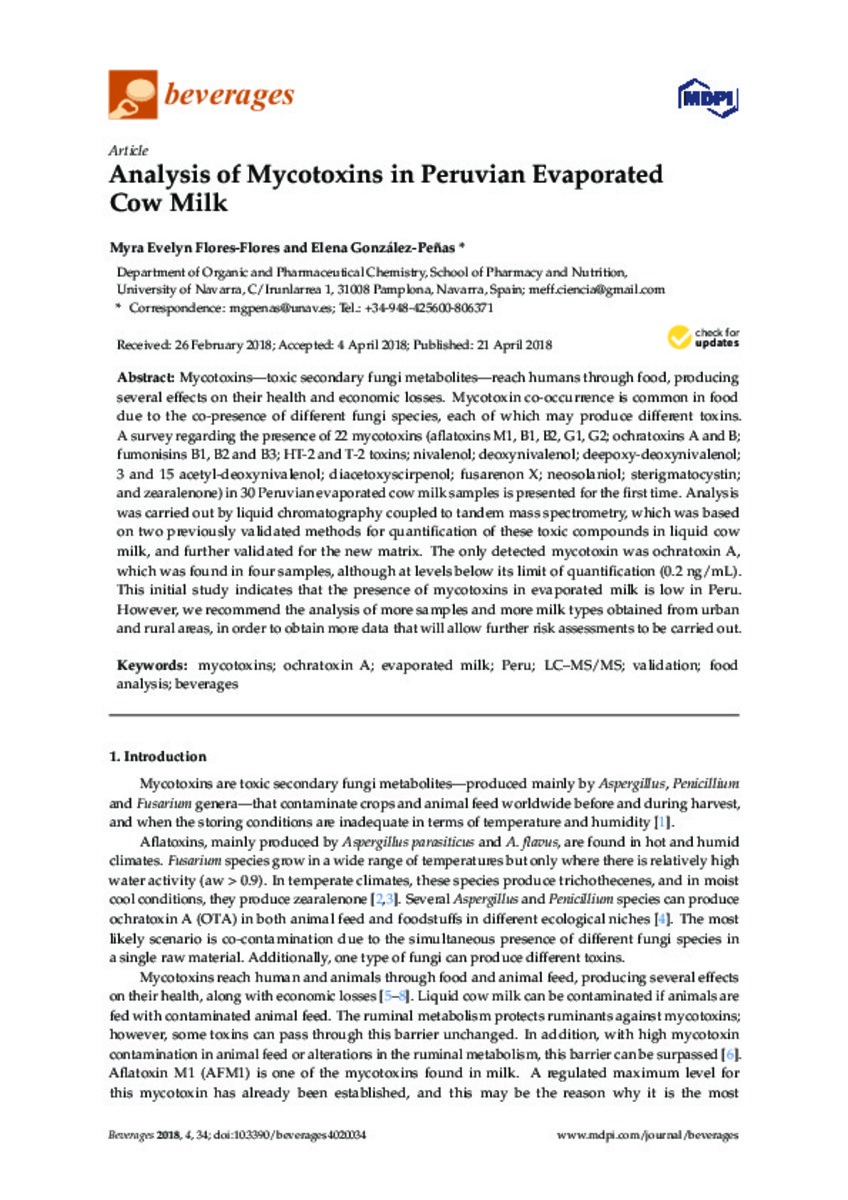Full metadata record
| DC Field | Value | Language |
|---|---|---|
| dc.creator | Flores-Flores, M.E. (Myra Evelyn) | - |
| dc.creator | Gonzalez-Peñas, E. (Elena) | - |
| dc.date.accessioned | 2019-09-05T08:06:43Z | - |
| dc.date.available | 2019-09-05T08:06:43Z | - |
| dc.date.issued | 2018 | - |
| dc.identifier.citation | Flores-Flores, M.E. (Myra Evelyn); Gonzalez-Peñas, E. (Elena). "Analysis of mycotoxins in peruvian evaporated cow milk". Beverages. 4 (2), 2018, 34 | es |
| dc.identifier.issn | 2306-5710 | - |
| dc.identifier.uri | https://hdl.handle.net/10171/58064 | - |
| dc.description.abstract | Mycotoxins—toxic secondary fungi metabolites—reach humans through food, producing several effects on their health and economic losses. Mycotoxin co-occurrence is common in food due to the co-presence of different fungi species, each of which may produce different toxins. A survey regarding the presence of 22 mycotoxins (aflatoxins M1, B1, B2, G1, G2; ochratoxins A and B; fumonisins B1, B2 and B3; HT-2 and T-2 toxins; nivalenol; deoxynivalenol; deepoxy-deoxynivalenol; 3 and 15 acetyl-deoxynivalenol; diacetoxyscirpenol; fusarenon X; neosolaniol; sterigmatocystin; and zearalenone) in 30 Peruvian evaporated cow milk samples is presented for the first time. Analysis was carried out by liquid chromatography coupled to tandem mass spectrometry, which was based on two previously validated methods for quantification of these toxic compounds in liquid cow milk, and further validated for the new matrix. The only detected mycotoxin was ochratoxin A, which was found in four samples, although at levels below its limit of quantification (0.2 ng/mL). This initial study indicates that the presence of mycotoxins in evaporated milk is low in Peru. However, we recommend the analysis of more samples and more milk types obtained from urban and rural areas, in order to obtain more data that will allow further risk assessments to be carried out. | es_ES |
| dc.description.sponsorship | We thank the “Programa de Investigación Universidad de Navarra” (PIUNA) and “Gobierno de Navarra” (Project number 0011-1383-2016-000013 PC007 DOTCO) for financial support. M. Flores-Flores wishes to express her gratitude to the “Asociación de Amigos de la Universidad de Navarra” (ADA) for the grant unding. | es_ES |
| dc.language.iso | eng | es_ES |
| dc.publisher | MDPI | es_ES |
| dc.rights | info:eu-repo/semantics/openAccess | es_ES |
| dc.subject | Mycotoxins | es_ES |
| dc.subject | Ochratoxin A | es_ES |
| dc.subject | Evaporated milk | es_ES |
| dc.subject | Peru | es_ES |
| dc.subject | LC–MS/MS | es_ES |
| dc.subject | Validation | es_ES |
| dc.subject | Food analysis | es_ES |
| dc.subject | Beverages | es_ES |
| dc.title | Analysis of mycotoxins in peruvian evaporated cow milk | es_ES |
| dc.type | info:eu-repo/semantics/article | es_ES |
| dc.description.note | This article is an open access article distributed under the terms and conditions of the Creative Commons Attribution (CC BY) license (http://creativecommons.org/licenses/by/4.0/). | es_ES |
| dc.identifier.doi | https://doi.org/10.3390/beverages4020034 | - |
| dc.identifier.doi | https://doi.org/10.3390/beverages4020034 | es_ES |
Files in This Item:
Statistics and impact
Items in Dadun are protected by copyright, with all rights reserved, unless otherwise indicated.






